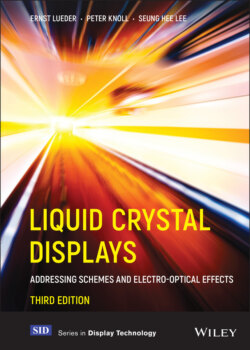Читать книгу Liquid Crystal Displays - Ernst Lueder - Страница 16
1
Introduction
ОглавлениеLiquid Crystal Displays (LCDs) have established a firm foothold on the market as flat panel displays for computers, transportation, communication (especially in its mobile version), instrumentation and, in the future, with increasing importance for television. The understanding of LCDs requires knowledge about the various electro-optical effects of liquid crystal cells, and about the control of the grey shades and colours in the picture elements (pixels, or pels) by addressing circuits.
The electro-optical effects are based either on the propagation of polarized light through anisotropic liquid crystal cells, or on the propagation of unpolarized light through scattering cells. The grey shade controlling voltage across each pixel is provided mainly by either passive matrix or active matrix addressing. In passive matrix addressing, the voltage in each pixel is generated by voltages at the end of the rows (or lines) and the columns of the display, whereas active matrix addressing uses Thin Film Transistors (TFTs) or Metal Insulator Metal (MIMs) devices as switches in each pixel.
Further topics are the fabrication of conductors, transparent electrodes, TFTs and MIMs with thin film technology, the generation of colour filters, and the assembly and bonding of liquid crystal cells.
It is not only manufacturers of LCDs but also the vast community of users which need to grasp the essence of the physics and engineering of LCDs. The understanding of these topics enables users to select the appropriate LCD for their application, to tailor the optic performance to their needs (e.g. by optimizing the waveform at the addressing circuit by the addition of performance- enhancing sheets, or by selecting the appropriate location of the external ICs for signal processing), as well as for storing and feeding in of the picture information.
Further, manufacturers and users should be enabled to judge the suitability of future developments and trends for their purposes.
The first section of this book presents an overview of the properties of liquid crystal materials and a phenomenological description of the most frequently used type of LCDs, the TFT- addressed twisted nematic (TN) LCD. The aim is to familiarize readers with the main aspects of LCDs, to introduce most of the terminology, to establish an understanding without doing calculations, and to alleviate the subsequent more detailed discussion without losing the overall picture in which the details are embedded.
The remaining portions of the book are devoted to an analytical investigation of the electro-optic effects, and to an elaboration of the addressing schemes complemented by the manufacture of the thin film components.
Applications are centred around transmissive and reflective displays and light valves for projectors. Plastic substrates and printing of layers replacing vacuum processes are examples of an emerging new display technology.
